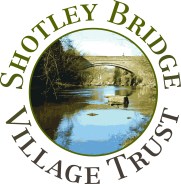Shotley House
This fine building is listed grade II, for its special architectural or historic interest. The walls and gate piers in front of Shotley House are also listed.
Although Historic England’s listing and the Durham at War website refer to Shotley House being built around 1860 for J Priestman [a Managing Director of the Consett Iron Company Ltd] there is some discrepancy about this.
Whellan’s Directory of 1856 shows Robert Dickinson [fire brick manufacturer] living at Shotley House. Kelly’s Directory of 1883 also shows Robert Dickinson [coal owner and colliery proprietor] living there, before his death in September 1884.
Additionally, the 1861 Census lists Jonathan Priestman living somewhere between Spa Well and Toll House, perhaps at Derwent Lodge where he was listed in both the 1868 Electoral Register and 1871 Census. He died in December 1888 at Shotley Lodge.
During the First World War, Shotley House became a 40 bed convalescent home treating 227 wounded soldiers. It was staffed by the Voluntary Aid Detachment unit 26 [under the command of Miss Walton Wilson]. This was a field nursing service trained to supplement the Territorial Forces Medical Service. For further information see the ‘Durham at War’ website.
It was later bought by the Peile Family and given/sold by Dr Henry Peile to Durham County Council to run as the E F Peile Convalescent Home, a pioneering venture for mothers, babies and children under five.
In 1981 it was sold by Durham County Council and converted into three separate dwellings: Shotley House at the front, Peile House at the rear with Shotley House Cottage in between. Originally there was a rear drive to a courtyard building with servants’ quarters and coach houses, built in 1876. Now known as Peile Court it was converted into 5 flats as part of the Peile Park housing development, accessed from Briary Gardens.
Jonathon’s son Lewis started a coaching business in 1891, when he bought his first coach ‘Venture’ and ran a service between Newcastle and Shotley Bridge. After the First World War he began a service to Blanchland but around 1930 he shortened the run to end at Edmundbyers.
With its distinctive red and gold paintwork, and four horses, the Venture Coach regularly passed through the village until 1939, by which time motorised transport had taken over. June 1967 saw the final outing for the Venture Coach.
His company, Venture Transport, became one of thebiggest independent bus operators in the North East, operating numerous services in and around the Derwent Valley. It was sold to the Northern General Transport Company in 1970.


